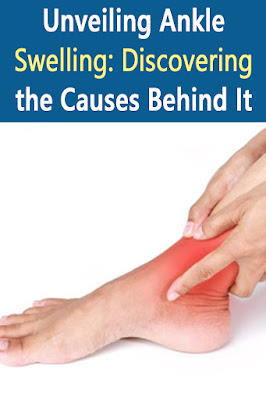Unveiling Ankle Swelling: Discovering the Causes Behind It
Ankle swelling, also known as edema, can be an unsettling and uncomfortable experience. It occurs when fluid accumulates in the tissues around your ankles, leading to noticeable swelling. Various factors can contribute to ankle swelling, ranging from temporary conditions to more serious health concerns. Here, we unveil the common causes behind ankle swelling and what you can do about it.
1. Injury or Trauma
Causes:
- Sprains, strains, fractures, and other injuries can cause swelling as the body's natural response to protect the area and promote healing.
Symptoms:
- Pain, bruising, reduced mobility, and tenderness around the affected area.
What to Do:
- Rest, ice, compression, and elevation (RICE) are essential. Seek medical attention if the swelling is severe or if you suspect a fracture.
2. Prolonged Standing or Sitting
Causes:
- Remaining in one position for extended periods can cause fluid to pool in your lower extremities due to gravity and poor circulation.
Symptoms:
- Swelling, usually mild, that resolves with movement and elevation.
What to Do:
- Take breaks to move around, elevate your feet when sitting, and avoid standing for too long.
3. Pregnancy
Causes:
- Hormonal changes and increased pressure on veins can lead to fluid retention and swelling in the ankles and feet, particularly in the third trimester.
Symptoms:
- Mild to moderate swelling, often worse in the evening and during warmer weather.
What to Do:
- Elevate your feet, stay hydrated, wear comfortable shoes, and avoid prolonged standing. Consult your healthcare provider if swelling is sudden or severe.
4. Obesity
Causes:
- Excess body weight increases pressure on veins, impeding blood flow and leading to fluid buildup in the ankles.
Symptoms:
- Persistent swelling that can worsen with inactivity and improve with weight loss and lifestyle changes.
What to Do:
- Adopt a balanced diet, engage in regular physical activity, and aim for gradual weight loss.
5. Heart Disease
Causes:
- Conditions like congestive heart failure can cause fluid retention, leading to swelling in the lower extremities.
Symptoms:
- Swelling in both ankles, shortness of breath, fatigue, and other heart-related symptoms.
What to Do:
- Seek immediate medical attention if you experience these symptoms. Managing heart disease is crucial for reducing swelling and improving overall health.
6. Kidney Disease
Causes:
- Impaired kidney function can lead to fluid retention and swelling in the ankles and feet.
Symptoms:
- Swelling, changes in urination, and general fatigue.
What to Do:
- Consult a healthcare provider for proper diagnosis and treatment. Managing kidney disease can help reduce swelling.
7. Liver Disease
Causes:
- Liver conditions such as cirrhosis can cause fluid buildup in the abdomen and lower extremities due to decreased production of proteins needed to regulate blood volume.
Symptoms:
- Swelling in the ankles, abdomen, and sometimes the hands, along with jaundice and fatigue.
What to Do:
- Seek medical advice if you suspect liver disease. Proper management of liver conditions is essential to reduce swelling and prevent complications.
8. Venous Insufficiency
Causes:
- When veins in the legs cannot effectively return blood to the heart, leading to blood pooling and fluid leakage into surrounding tissues.
Symptoms:
- Chronic swelling, varicose veins, and skin changes around the ankles.
What to Do:
- Compression stockings, regular exercise, and elevating your legs can help. Consult a healthcare provider for more advanced treatments if necessary.
9. Medications
Causes:
- Certain medications, including blood pressure medications, steroids, and nonsteroidal anti-inflammatory drugs (NSAIDs), can cause fluid retention.
Symptoms:
- Swelling that begins after starting a new medication.
What to Do:
- Discuss with your healthcare provider. They may adjust your dosage or suggest alternative medications.
10. Infections
Causes:
- Infections in the foot or ankle, such as cellulitis, can cause significant swelling and redness.
Symptoms:
- Swelling, warmth, redness, pain, and sometimes fever.
What to Do:
- Seek immediate medical attention if you suspect an infection. Early treatment is crucial to prevent complications.
Conclusion
Ankle swelling can have numerous causes, some of which require medical intervention. Understanding the underlying reasons can help you manage the condition effectively and seek appropriate treatment when necessary. If you experience persistent, severe, or unexplained swelling, it's important to consult a healthcare provider to determine the cause and receive proper care. By addressing the root cause of ankle swelling, you can improve your comfort, mobility, and overall health.
